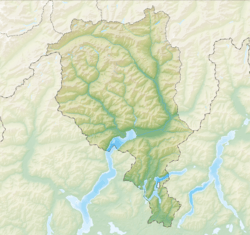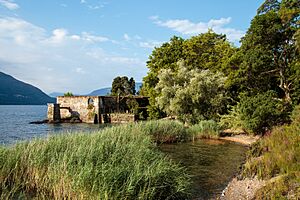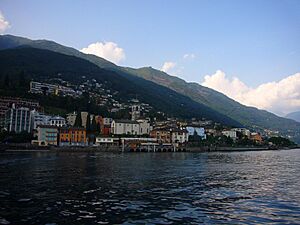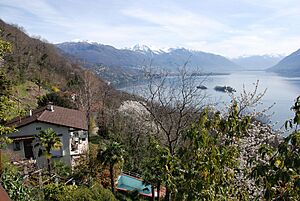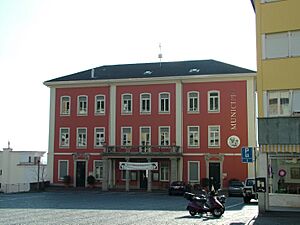Brissago facts for kids
Quick facts for kids
Brissago
|
||
|---|---|---|
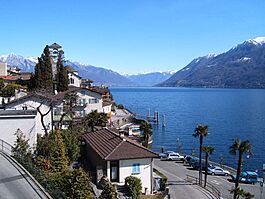 |
||
|
||
| Country | Switzerland | |
| Canton | Ticino | |
| District | Locarno | |
| Area | ||
| • Total | 17.8 km2 (6.9 sq mi) | |
| Elevation | 197 m (646 ft) | |
| Population
(Dec 2020 )
|
||
| • Total | 1,685 | |
| • Density | 94.66/km2 (245.2/sq mi) | |
| Postal code |
6614
|
|
| Surrounded by | Ascona, Cannobio (IT-VB), Caviano, Gerra (Gambarogno), Intragna, Maccagno con Pino e Veddasca (IT-VA), Palagnedra, Ronco sopra Ascona, San Nazzaro, Sant'Abbondio, Tronzano Lago Maggiore (IT-VA), Valle Cannobina (IT-VB). | |
Brissago is a town in Switzerland. It is located in the canton of Ticino. Brissago borders Italy.
The town sits on the western shore of Lake Maggiore. It also includes the famous Brissago Islands.
Contents
Discovering Brissago's Past
Early Settlements and Roman Times
People have lived in the Brissago area for a very long time. In 1846, an ancient axe and pottery pieces were found. These items date back to the Neolithic era, which was the New Stone Age. Roman coins and other artifacts were also discovered. These finds show that people lived here even before recorded history. In 1863, more graves were found during road construction.
How Brissago Got Its Name
Brissago was first written about in the year 1289. Back then, it was called Brixago. It was also known by the German name Brisa for a while. However, this old German name is not used anymore.
Brissago's Independence Journey
During the Middle Ages, Brissago was connected to the nearby town of Cannobio. But Brissago slowly gained more freedom. By the mid-1200s, it had its own local laws. The town was made up of three main groups of villagers. These groups were called vicinia.
The local council chose three leaders, called Consoli. Each vicinia had one leader. A main ruler, called a Podestà, governed the whole town. This ruler was first chosen by the powerful Visconti family from Milan. Later, from 1342 until 1798, the Podestà always came from the Orelli family.
In 1520, Brissago became an independent republic. It then joined the Old Swiss Confederacy as an associate. This meant it was connected to Switzerland but still had special rights. It kept its own Podestà ruler. In 1803, Brissago became a fully independent town in the new Canton of Ticino.
Brissago's Role in Italian History
During the Italian Risorgimento (a movement to unite Italy), Brissago played a secret role. It became a safe place for Italian refugees. It was also a center for smuggling weapons and hidden literature.
Churches and Famous Islands
The main church in Brissago is called SS Pietro e Paolo. It was first mentioned in the 1200s. The current building was built between the 1500s and 1600s.
The Brissago Islands are very famous. In 1885, Baroness Antonietta Saint-Léger bought the two islands. She created a beautiful botanical garden and a villa on Isola Grande. This villa became a place where artists and thinkers met. Later, in 1927, Max Emden built a new palace there.
In 1949, several groups bought the islands together. These included the canton of Ticino and the towns of Brissago, Ascona, and Ronco sopra Ascona. Since 1950, the botanical garden on Isola Grande has been open to everyone.
How Brissago's Economy Changed
For a long time, most people in Brissago worked in farming and raising animals. Some also fished or traded goods. There were also mills and sawmills. Many people from Brissago moved to other places like Milan to find work. They often became cooks or hotel workers.
A big change happened in 1854 when a spinning mill opened. Two years later, it became a tobacco factory. This factory grew, and by the early 1900s, over 600 people worked there. Most of them were women.
Around this time, Brissago also started to become a popular place for tourists. Many hotels and vacation homes were built. The Grande Albergo hotel was built in 1907, but it was taken down in 1993. After 1970, most jobs in Brissago were in the service industry, like hotels and shops. The town also grew up the hillsides, becoming a larger residential area.
Brissago's Location and Landscape
Brissago is located in the Locarno district. It sits right on the shores of Lake Maggiore. The town's area is about 17.79 square kilometers (6.87 square miles).
Most of Brissago's land is covered by forests (66.6%). About 7% is used for farming. Another 7% is covered by buildings and roads. Rivers and lakes make up 1.8% of the area. The rest, about 19.2%, is unproductive land like rocky areas.
The town is divided into three parts along the shoreline. It also includes the two famous islands: Isola Grande and Sant'Apollinare. Brissago is on the road that leads to Ascona and the Italian border. Many small sections of the town are scattered in the hills. These roads lead up to Mount Gridone, which is 2,188 meters (7,178 feet) high.
Getting Around Brissago
You can travel to Brissago by boat. Regular boat services and faster hydrofoil services run from Locarno. They stop at Brissago, Ascona, and the Isole di Brissago (Brissago Islands). The Brissago Islands have a special botanical garden. You can even see coffee plants and peacocks there!
Brissago's Town Symbol
The official symbol, or coat of arms, of Brissago shows a red cross on a silver background. In one corner, there is a picture of Saint George. He is riding a silver horse and killing a green dragon. This image is important because it refers to April 24, 1520. On that day, Brissago decided to ask for protection from the Swiss.
People of Brissago
Population and Languages
Brissago has a population of about 1,877 people (as of 2004). About 18.3% of the people living in Brissago are from other countries.
Most people in Brissago speak Italian (69.1%). The second most common language is German (24.9%). A small number of people also speak French (1.3%).
Age Groups
In Brissago, about 5.8% of the population are children under 9 years old. Teenagers (10-19 years old) make up about 7% of the population. The largest group of people are seniors. About 19.1% of the population is between 60 and 69 years old.
Homes in Brissago
In 2000, there were 862 private homes in Brissago. On average, about 1.9 people lived in each home. Most of the buildings (67%) were single-family homes. Many apartments in Brissago are used only during certain seasons, like for vacations. About 63.9% of apartments were used seasonally.
Population Changes Over Time
The population of Brissago has changed over the years.
| year | population |
|---|---|
| 1578 | 1,675 |
| 1801 | 1,330 |
| 1850 | 1,266 |
| 1860 | 1,136 |
| 1900 | 1,639 |
| 1930 | 1,577 |
| 1950 | 1,931 |
| 1970 | 2,120 |
| 1990 | 1,909 |
| 2000 | 1,833 |
Important Heritage Sites
Several places in Brissago are considered very important to Switzerland's history and culture. These are called "heritage sites of national significance."
- The Ruggero Leoncavallo Museum
- The churches of Madonna del Ponte and Santuario di S. Maria Addolorata del Sacro Monte
- The botanical garden and special site on Isole di Brissago
The entire Isole di Brissago area is also part of the Inventory of Swiss Heritage Sites.
Brissago's Economy
In 2007, Brissago had a low unemployment rate of 3.39%. This means most people who wanted to work had jobs.
Types of Jobs
- Primary sector: This includes jobs like farming and fishing. In 2005, 38 people worked in this area.
- Secondary sector: This includes jobs in factories and manufacturing. 215 people worked in this sector.
- Tertiary sector: This includes jobs in services, like hotels, shops, and offices. This is the largest sector, with 879 people working here.
Many people travel into Brissago for work. In 2000, 1,054 workers came into the town, while only 284 left to work elsewhere. This shows that Brissago offers many job opportunities.
Tourism and Hotels
Tourism is a big part of Brissago's economy. In 2009, there were 10 hotels in the town. These hotels had a total of 225 rooms and 436 beds for visitors.
Religion in Brissago
According to the 2000 census, most people in Brissago are Roman Catholic (71.8%). About 14.2% belong to the Swiss Reformed Church. A small number of people belong to other churches or did not state their religion.
Brissago's Weather
Brissago gets a lot of rain or snow each year. On average, it has about 99.1 days with precipitation. The total amount of rain is about 2019 millimeters (79.5 inches) per year.
The wettest month is September, with an average of 241 millimeters (9.5 inches) of rain. May has the most rainy days, with about 12.3 days of precipitation. The driest month is December, with only about 73 millimeters (2.9 inches) of rain.
Education in Brissago
Switzerland is known for its good education system. In Brissago, about 67.5% of adults (aged 25–64) have completed higher education. This means they finished high school or went to a university or college.
Schools in Brissago
In 2009, there were 204 students in Brissago.
- Kindergarten: Children can attend non-mandatory kindergarten for up to three years. In Brissago, 29 children were in kindergarten.
- Primary School: This program lasts for five years. 56 students attended standard primary schools.
- Lower Secondary School: Students can choose different paths here. Some go to a two-year middle school. Others go to a four-year program to prepare for higher education.
- Upper Secondary School: After this, students are ready for a job or to go to university. There are vocational programs that prepare students for specific trades.
- Professional Programs: These programs last three years. They prepare students for jobs in fields like engineering or nursing.
Many students from Brissago attend schools outside the town. In 2000, 127 residents went to schools in other municipalities.
Famous People from Brissago
- Nella Martinetti (1946-2011): She was a Swiss singer and songwriter.
Images for kids
See also
 In Spanish: Brissago para niños
In Spanish: Brissago para niños




